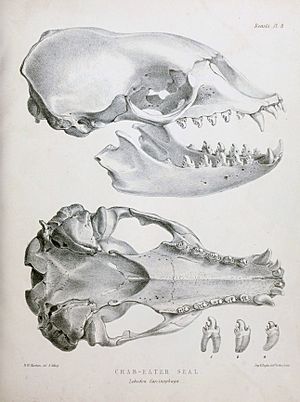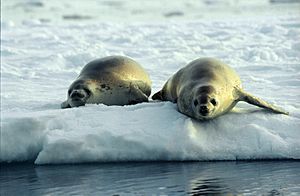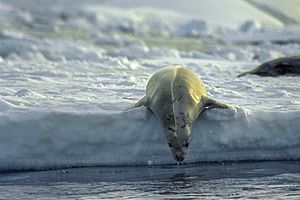Crabeater seal facts for kids
Quick facts for kids Crabeater seal |
|
|---|---|
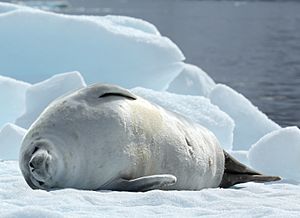 |
|
| Conservation status | |
| Scientific classification | |
| Genus: |
Lobodon
|
| Species: |
carcinophaga
|
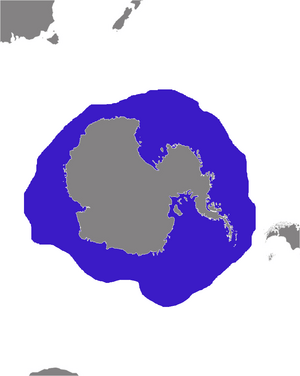 |
|
| Distribution of crabeater seal | |
| Synonyms | |
|
Lobodon carcinophagus |
|
The crabeater seal (Lobodon carcinophaga) is also called the krill-eater seal. It's a type of true seal that lives all around the coast of Antarctica. These seals are medium to large, usually over 2 meters (6.5 feet) long. They are quite slender and have pale fur.
You'll mostly find them on the pack ice that floats away from the Antarctic coast. They use this ice to rest, find partners, gather in groups, and hunt for food. Crabeater seals are the most common seal species in the world. There are at least 7 million, and maybe even up to 75 million of them!
They are so successful because they specialize in eating Antarctic krill. Krill are tiny shrimp-like creatures found in huge numbers in the Southern Ocean. Crabeater seals have special sieve-like teeth to filter krill from the water. Their scientific name, Lobodon carcinophaga, means "lobe-toothed crab eater." But don't let the name fool you – they don't eat crabs at all!
Young crabeater seals are an important food source for leopard seals. Leopard seals are responsible for most of the deaths of crabeater seal pups.
Contents
About Crabeater Seals
Crabeater seals are part of a group called lobodontine seals. This group also includes the leopard seal, Ross seal, and Weddell seal. All these seals share a special tooth design. Their teeth have lobes and cusps, which are perfect for straining small prey from the water.
Scientists believe these seals came from a common ancestor. They likely moved south to Antarctica a long time ago, when the area was warmer. They then developed into the different seal species we see today.
What Crabeater Seals Look Like
Adult crabeater seals are usually about 2.3 m (7.5 ft) long. They weigh around 200 kg (440 lb). Female seals are a bit longer and heavier than males. However, their weight changes a lot depending on the season. Females can lose half their body weight after having pups. Males also lose weight while looking for mates and fighting rivals.
Pups are born at about 1.2 metres (3.9 ft) long and weigh 20 to 30 kilograms (44 to 66 lb). They grow very fast, gaining about 4.2 kilograms (9.3 lb) each day. By the time they stop nursing (after two or three weeks), they weigh around 100 kilograms (220 lb).
Crabeater seals have brown or silver fur. Their flippers are usually darker. Their fur fades throughout the year. So, seals that have just shed their old fur look darker. Those about to shed look silvery-white. They have slender bodies and pointed snouts.
These seals can lift their heads and arch their backs when on ice. They can move very quickly on ice if they don't get too hot. Many crabeater seals have scars. These come from leopard seal attacks, especially around their flippers. Male seals might also get scars on their throats and jaws from fighting during breeding season.
Baby seals are born with light brown, fuzzy fur. They shed this fur when they stop nursing. Younger seals often have net-like, chocolate brown marks on their bodies. These marks are often from leopard seal attacks. After shedding, their fur is a darker brown, becoming blonde on their bellies. It gets lighter throughout the year, turning completely blonde in summer.
Their most amazing feature is their teeth. They are specially designed to filter Antarctic krill. Their back teeth have many small points. When their jaws close, these teeth fit together tightly. This creates a perfect sieve to trap krill.
Where Crabeater Seals Live
Crabeater seals live all around Antarctica. Sometimes, they are seen or get stranded on the southern coasts of Brazil, South Africa, Australia, and New Zealand. They stay in the pack ice zone all year long. This ice moves closer and further from the continent with the seasons. They prefer waters less than 600 meters (2,000 feet) deep.
They first arrived in Antarctica millions of years ago. At that time, the region was much warmer. The seals all over Antarctica are connected and mix well. This means there aren't different types or subspecies of crabeater seals.
It's hard to know exactly how many crabeater seals there are. Past guesses ranged from 2 million to 75 million! The most recent estimate is about 7 million seals. But even this number might be too low. Scientists are working together to get better counts of all Antarctic seals.
How Crabeater Seals Behave
Crabeater seals move in a wavy way on ice or land. They pull their front flippers in and wiggle their backs. This leaves a unique wavy track. They can move very fast, up to 19–26 km/h (12–16 mph) (12-16 mph) for short bursts on cold days. In the water, they can swim about 66 km (41 miles) in a day. They can also swim at speeds of 12.7 km/h (7.9 mph) (8 mph).
When swimming, crabeater seals sometimes "porpoise." This means they leap completely out of the water. They also "spyhop," which is when they raise their bodies vertically out of the water to look around.
These seals are the most social of the Antarctic seals. You can see groups of up to 1,000 seals resting on the ice. In the water, groups of hundreds might swim, dive, and breathe at the same time. These large groups are usually made up of younger seals. Adult seals are more often found alone or in small groups of two or three.
Crabeater seals have their babies during the Antarctic spring, from September to December. Females give birth alone on the ice. Adult males stay with the female and her pup. They wait until the female is ready to mate, which is about one to two weeks after the pup stops nursing. Scientists haven't seen them mate directly, but it probably happens in the water. Pups stop nursing after about three weeks. At this time, they also start to shed their baby fur.
Interestingly, crabeater seals have been found far inland, further than any other seal. Their bodies have been discovered over 100 km (60 miles) from the water. Some were even found over 1000 meters (3,300 feet) above sea level. The dry, cold air can preserve their bodies for hundreds of years.
What Crabeater Seals Eat
Their Diet

Even though they are called "crabeater seals," they don't eat crabs. Crabs in their area live in very deep water. Instead, they are specialists in eating Antarctic krill. Krill make up over 90% of their diet! The huge number of crabeater seals shows how successful Antarctic krill are. Krill have the largest total weight of any single animal species on Earth.
Crabeater seals don't change what they eat much throughout the year. Sometimes, they might target adult or male krill. They also eat a few other things, like squid and different types of Antarctic fish. Other Antarctic seals, like Weddell, Ross, and leopard seals, live in the same areas. But because crabeater seals only eat krill, they don't compete with the other seals for food.
In the past, many large whales, like blue whales, were hunted. This meant there was a lot more krill available. Scientists think that the number of crabeater seals might have increased a lot in the 20th century because of this.
Who Hunts Them
Young crabeater seals are often hunted by leopard seals. Many young seals, possibly up to 80%, die in their first year. Up to 78% of crabeater seals that survive their first year have scars from leopard seal attacks. You can see long scars and parallel marks on their pale fur. These scars are on almost all young seals. But older seals have fewer scars. This suggests that leopard seals mainly hunt the youngest seals. This high risk of being hunted affects how crabeater seals live and behave. It might be why younger seals gather in large groups.
Killer whales (orcas) also hunt crabeater seals, but this is not seen as often. Orcas hunt seals of all ages. Sometimes, groups of killer whales work together. They create a wave to wash a seal off the ice into the water. However, orcas often prefer to hunt other types of seals. Crabeater seals are known to be tough and can be more trouble to catch than they're worth.
Gallery
See also
 In Spanish: Foca cangrejera para niños
In Spanish: Foca cangrejera para niños



